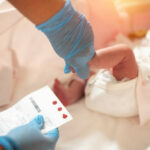Neonatal respiratory distress syndrome (RDS) is a common and serious condition that primarily affects premature newborns. It occurs when a baby’s lungs are underdeveloped and lack sufficient surfactant, a substance critical for keeping the tiny air sacs (alveoli) in the lungs open. Without adequate surfactant, breathing becomes difficult, leading to inadequate oxygen levels in the blood. Early recognition and treatment of RDS are crucial for improving outcomes and reducing complications.

1. Causes of Neonatal RDS
- Prematurity: The most common cause, as surfactant production typically begins around the 24th to 28th week of gestation and becomes sufficient by 35–36 weeks.
- Maternal Diabetes: High blood sugar levels can delay fetal lung maturity.
- Cesarean Delivery: Lack of hormonal and physical stress during a cesarean may reduce surfactant release.
- Genetic Factors: Some infants may have a genetic predisposition to insufficient surfactant production.
2. Signs and Symptoms
Symptoms of RDS typically appear within minutes to hours after birth:
- Rapid Breathing (Tachypnea): Respiratory rate over 60 breaths per minute.
- Grunting Sounds: A sign the baby is struggling to keep air in the lungs.
- Nasal Flaring: Widening of the nostrils during breathing as an effort to draw in more air.
- Chest Retractions: The skin around the ribs or chest sinks in with each breath.
- Cyanosis: Bluish discoloration of the skin due to low oxygen levels.
3. Diagnosis of RDS
RDS is diagnosed based on clinical symptoms and diagnostic tests:
- Chest X-ray: Shows characteristic “ground-glass” opacity and air bronchograms in the lungs.
- Blood Gas Analysis: Indicates low oxygen levels and increased carbon dioxide.
- Prenatal History: Premature birth or other risk factors help identify at-risk infants.
4. Treatment Options
Management of RDS aims to improve oxygenation and support the baby’s breathing:
- Surfactant Therapy: Administered through a breathing tube directly into the baby’s lungs, surfactant replacement improves lung function and reduces the severity of RDS.
- Oxygen Therapy: Supplemental oxygen is provided to maintain adequate oxygen levels.
- Mechanical Ventilation: In severe cases, a ventilator supports the baby’s breathing.
- Continuous Positive Airway Pressure (CPAP): A non-invasive method to keep the baby’s airways open and improve oxygenation.
- Supportive Care: Includes keeping the baby warm, managing fluids, and monitoring for complications.
5. Complications of RDS
Without proper treatment, RDS can lead to serious complications:
- Chronic Lung Disease (Bronchopulmonary Dysplasia): Resulting from prolonged ventilation and oxygen therapy.
- Pneumothorax: Air leaks into the space between the lungs and chest wall due to overdistension.
- Infections: Increased risk due to weakened immunity.
- Neurological Damage: Prolonged oxygen deprivation can affect brain development.
6. Prevention of RDS
- Antenatal Corticosteroids: Given to mothers at risk of preterm delivery to accelerate fetal lung maturation and surfactant production.
- Delayed Delivery: Whenever possible, prolonging pregnancy allows the lungs more time to mature.
- Management of Maternal Conditions: Treating maternal diabetes or infections can reduce the risk of RDS.
Conclusion
Neonatal respiratory distress syndrome is a significant challenge for premature infants, but advances in medical care have greatly improved survival rates and outcomes. With timely diagnosis, effective treatments like surfactant therapy, and preventive measures, many affected newborns go on to lead healthy lives. Early intervention and comprehensive care remain key to managing this critical condition.







